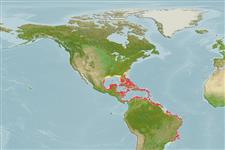Classification / Names
Common names | Synonyms | Catalog of Fishes (gen., sp.) | ITIS | CoL | WoRMS | Cloffa
Actinopterygii (ray-finned fishes) >
Perciformes (Perch-likes) >
Labridae (Wrasses) > Corinae
Etymology: Halichoeres: Greek, als, alis = salt + Greek, choiros = pig (Ref. 45335).
Environment / Climate / Range
Ecology
Marine; reef-associated; depth range 3 - 60 m (Ref. 52607). Tropical, preferred ?
Southwest Atlantic: French Guiana to the State of São Paulo, Bazil.
Size / Weight / Age
Maturity: Lm ? range ? - ? cm
Max length : 27.0 cm SL male/unsexed; (Ref. 114982)
Dorsal
spines
(total): 9;
Dorsal
soft rays
(total): 12;
Anal
spines: 3;
Anal
soft rays: 12. Juveniles and females blue with a bright yellow region dorsally from mouth to posterior base of dorsal fin; caudal fin with a single dark spot. Adults with a broad blue stripe on upper half of body ending at the beginning of the caudal fin; lower half of body light blue; a diagonal dark band from eye to nape. Two pairs of enlarged canine teeth anteriorly in the lower jaw (Ref. 52607).
Usually observed solitary; juveniles relatively common in shallow waters (3 - 20 meters) while adults are in deeper waters (30 - 60 meters) (Ref. 52607).
Life cycle and mating behavior
Maturity | Reproduction | Spawning | Eggs | Fecundity | Larvae
Distinct pairing during breeding (Ref. 205).
Rocha, L.A., 2004. Mitochondrial DNA and color pattern variation in three Western Atlantic Halichoeres (Labridae), with the revalidation of two species. Copeia 2004(4):770-782. (Ref. 52607)
IUCN Red List Status (Ref. 115185)
CITES (Ref. 94142)
Not Evaluated
Threat to humans
Harmless
Human uses
More information
Common namesSynonymsMetabolismPredatorsEcotoxicologyReproductionMaturitySpawningFecundityEggsEgg development
ReferencesAquacultureAquaculture profileStrainsGeneticsAllele frequenciesHeritabilityDiseasesProcessingMass conversion
Tools
Special reports
Download XML
Internet sources
